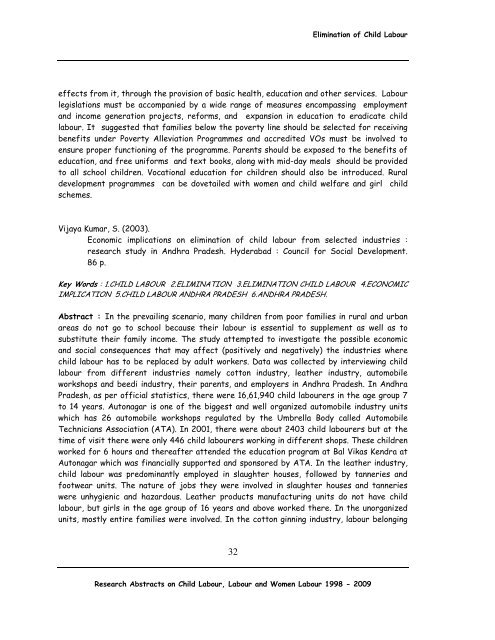Research Abstracts on Child Labour Women Labour - Nipccd
Research Abstracts on Child Labour Women Labour - Nipccd
Research Abstracts on Child Labour Women Labour - Nipccd
Create successful ePaper yourself
Turn your PDF publications into a flip-book with our unique Google optimized e-Paper software.
Eliminati<strong>on</strong> of <strong>Child</strong> <strong>Labour</strong><br />
effects from it, through the provisi<strong>on</strong> of basic health, educati<strong>on</strong> and other services. <strong>Labour</strong><br />
legislati<strong>on</strong>s must be accompanied by a wide range of measures encompassing employment<br />
and income generati<strong>on</strong> projects, reforms, and expansi<strong>on</strong> in educati<strong>on</strong> to eradicate child<br />
labour. It suggested that families below the poverty line should be selected for receiving<br />
benefits under Poverty Alleviati<strong>on</strong> Programmes and accredited VOs must be involved to<br />
ensure proper functi<strong>on</strong>ing of the programme. Parents should be exposed to the benefits of<br />
educati<strong>on</strong>, and free uniforms and text books, al<strong>on</strong>g with mid-day meals should be provided<br />
to all school children. Vocati<strong>on</strong>al educati<strong>on</strong> for children should also be introduced. Rural<br />
development programmes can be dovetailed with women and child welfare and girl child<br />
schemes.<br />
Vijaya Kumar, S. (2003).<br />
Ec<strong>on</strong>omic implicati<strong>on</strong>s <strong>on</strong> eliminati<strong>on</strong> of child labour from selected industries :<br />
research study in Andhra Pradesh. Hyderabad : Council for Social Development.<br />
86 p.<br />
Key Words : 1.CHILD LABOUR 2.ELIMINATION 3.ELIMINATION CHILD LABOUR 4.ECONOMIC<br />
IMPLICATION 5.CHILD LABOUR ANDHRA PRADESH 6.ANDHRA PRADESH.<br />
Abstract : In the prevailing scenario, many children from poor families in rural and urban<br />
areas do not go to school because their labour is essential to supplement as well as to<br />
substitute their family income. The study attempted to investigate the possible ec<strong>on</strong>omic<br />
and social c<strong>on</strong>sequences that may affect (positively and negatively) the industries where<br />
child labour has to be replaced by adult workers. Data was collected by interviewing child<br />
labour from different industries namely cott<strong>on</strong> industry, leather industry, automobile<br />
workshops and beedi industry, their parents, and employers in Andhra Pradesh. In Andhra<br />
Pradesh, as per official statistics, there were 16,61,940 child labourers in the age group 7<br />
to 14 years. Aut<strong>on</strong>agar is <strong>on</strong>e of the biggest and well organized automobile industry units<br />
which has 26 automobile workshops regulated by the Umbrella Body called Automobile<br />
Technicians Associati<strong>on</strong> (ATA). In 2001, there were about 2403 child labourers but at the<br />
time of visit there were <strong>on</strong>ly 446 child labourers working in different shops. These children<br />
worked for 6 hours and thereafter attended the educati<strong>on</strong> program at Bal Vikas Kendra at<br />
Aut<strong>on</strong>agar which was financially supported and sp<strong>on</strong>sored by ATA. In the leather industry,<br />
child labour was predominantly employed in slaughter houses, followed by tanneries and<br />
footwear units. The nature of jobs they were involved in slaughter houses and tanneries<br />
were unhygienic and hazardous. Leather products manufacturing units do not have child<br />
labour, but girls in the age group of 16 years and above worked there. In the unorganized<br />
units, mostly entire families were involved. In the cott<strong>on</strong> ginning industry, labour bel<strong>on</strong>ging<br />
32<br />
<str<strong>on</strong>g>Research</str<strong>on</strong>g> <str<strong>on</strong>g>Abstracts</str<strong>on</strong>g> <strong>on</strong> <strong>Child</strong> <strong>Labour</strong>, <strong>Labour</strong> and <strong>Women</strong> <strong>Labour</strong> 1998 - 2009

















